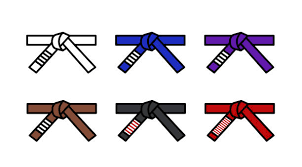Table of Contents

Cameron
Many white belts struggle with tying their belt in their first couple weeks of practice. It takes a while to get the movement down swiftly. So what are the actions you can take to swiftly and effectively tie your BJJ belt?
Here is a video on How to Tie Your BJJ Belt:
Steps To Tie A Brazilian Jiu-Jitsu Belt
-
Join the Martial Arts Community:
The majority of grappling artists wear formal attire known as a kimono. To keep this uniform on, students of martial arts wear a belt.
Not only do these belts keep your Gi on, but they also symbolize your experience level in the sport! To tie your BJJ belt, you have to become a part of the Brazilian Jiu-Jitsu community.
-
Fix Your Kimono:
There is a specific way to wear your kimono before you wrap your belt around your waist.
To begin, hold your belt in one hand while using your fingers and your free hand to push your right collar against your body.
Once you have put your right side down, you want to place your left collar on top of the right one.

-
Even Out and Wrap Your Belt:
The most basic way of tying your belt is universally known as the Square Knot A.K.A the Granny knot. Hold your belt out in front of your belly button making sure that both ends of the belt are similar in length.
Then, wrap your belt around your waist. As your hands meet in the back, cross your belt and switch each end to the opposite hand.
Once your belt is wrapped around your waist, pull the ends back to the front of your stomach.
-
Tie the First Layer:
Take the right part of your BJJ belt and cross it over the left. Then, loop the right end under both layers of the belt and pull the end through. Tug the tail end of each side of the belt to ensure there is no slack.
-
Finish the final knot:
The ending knot is the simplest part of the whole process. Once you have made sure your kimono is worn properly, the belt is at equal length, and you have gone through the wrapping, and looping process, you are finally ready to tie your BJJ belt.
The last step is to simply tie your belt as you would tie a shoelace; the left end wraps over and loops under the right end and boom! You are ready for the close combat training that you’ve been asking for!
There are many other forms apart from the basic method of tying your belt. These fancy styles are often used by black belts but can be picked up by a white belt with enough practice.
The most used alternative to the granny knot (the basic way of tying a BJJ belt) is a method known as the Double Water Knot.
Although this keeps the belt tied firmer, it takes an exceptional amount of time to tie compared to the basic Square Knot.
It is important to note that although this style of knot is proper etiquette in the sport of Jiu-Jitsu, there are times during hard rounds that it may come off.
A new student may be tempted to tie their belt mid-roll. Although there is no law against the action unless you compete, it is okay to continue training if the belt comes off.
Be careful though! Many Jiu-Jitsu practitioners base their fight strategy around using your lapel to attack different methods of sweeps, submissions, and passes!
Premium fight wear for BJJ, MMA, & more. Shop a wide range of premium quality fight wear for mean, women, and kids at affordable prices.
Different Types of Belts
The type of belt you invest in is important for physical comfort and aesthetic. If you look and feel good in your Brazilian Jiu-Jitsu uniform, your confidence is going to skyrocket!
In general, there is only one type of Jiu-Jitsu belt that people use worldwide. That is the typical 100% cotton belt that you can find around almost every online corner.
These stylish, traditional belts typically don’t come in different forms, but they do come in different styles and colors.
On the end of each BJJ belt, there is typically a brand tag; these differ between businesses. Some companies make their Jiu-Jitsu belts a shade lighter, others go for a darker, more serious tone.
At the end of the day, nearly all of them are made of the same thing and the choice is almost ultimately cosmetic.
Although No-Gi Jiu-Jitsu does not require practitioners to wear a belt and kimono, the sport does have its ranking system.
Typically, practitioners of the sport wear a rash guard that correlates to their belt ranking. If the athlete is a blue belt, they wear a blue rash guard instead. If a grappler has made it up to their brown belt, they will typically wear a brown rash guard during practice and competition.
Additionally, a lot of No-Gi schools will allow their students to wear any color rash guard they desire, but on promotion day, they are required to bring their Gi just in case they were chosen to get a new belt or stripe.

Why Tie Your Belt In the First Place?
There are a few reasons to tie your BJJ belt before stepping on the mat.
First and foremost, it is important to note that your belt is a symbol of discipline, dedication, and knowledge.
Even though nowadays many professors do not mind if your belt comes off in the middle of practice, it is traditional and formal to keep your belt tied at all times during a Jiu-Jitsu workout. The only exception to this rule is during live rounds.
If your belt comes off during a roll or a match it is acceptable to place it to the side (do not throw it) and continue the match.
Additionally, tying your belt keeps your Jiu-Jitsu Gi closed and formal. When your kimono is hanging outside of your belt, it can be gripped and used against you.
In BJJ, many practitioners use the uniform to play worm guard, establish a dominant position using grips, and even submit their opponents.
Although it is nearly inevitable to avoid a belt untying in a high-paced round, a proper knot could be the difference between a match won, or a match lost by a submission.

When you tie a Jiu-Jitsu belt and step on the mat, you are sacrificing a lot. You set aside your time, pride, and safety to participate in the grappling combat sport. No matter how you tie your belt, whether it be a Square Knot or any alternative, be proud of what you are wearing. Not many people have the guts to step into a martial arts gym.
Whether you're looking for a natural way to support wellness, manage stress, or address specific health concerns, CBDmd's products are designed to meet various needs.
- Product for almost every need
- Easy to buy with quick delivery times


